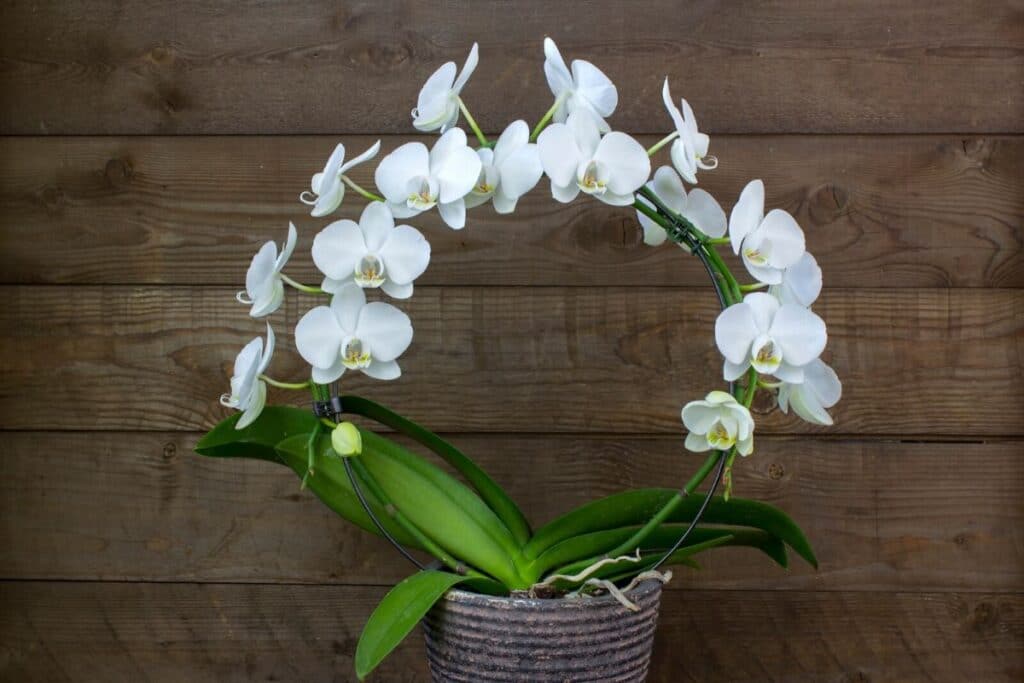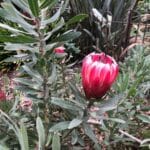Phalaenopsis, otherwise known as moth orchids or butterfly orchids, are a popular type of orchid that many flower enthusiasts adore.
Though orchids, in general, flaunt a striking appearance, the dramatic flower spikes of phals make them stand out. Each long and arching flower spike displays many blooms at a time, and their large, moth-like flowers come in a wide variety of attractive hues.
Phalaenopsis orchids are one of the easiest types of orchids to grow and maintain, making them an ideal choice even for first-time gardeners and one of the widely traded types of orchids worldwide (1). Their blooms last a long time, too.
Read on below to know more about the lovely phalaenopsis orchids.
The Genus Phalaenopsis: An Overview
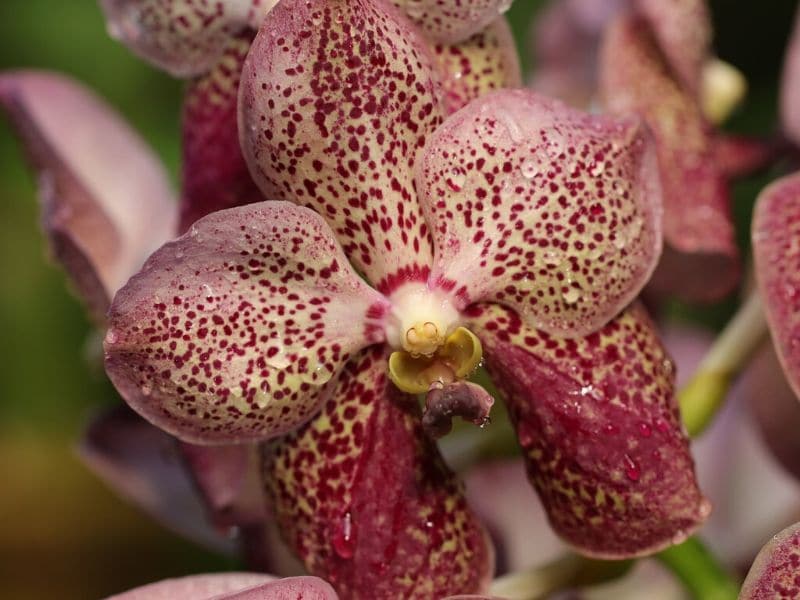
Phalaenopsis is one of the many genera in the Orchidaceae family. It is native to Southeast Asia and the Pacific Islands and can also be found in India and the northern part of Australia. The primary center of distribution of this orchid genus is the Philippines, where 14 Phalaenopsis species are endemic (1).
Phalaenopsis orchids grow in low elevations of up to 1500 meters above sea level (1). They can be monopodial epiphytes or lithophytes, depending on the species. It means that they grow upright or vertically either on other miniature plants (mostly trees) or rocks (2).
Name Origin

The genus name Phalaenopsis originated in 1825 when German-Dutch botanist Carl Ludwig Blume first described the plant in his book. The name came from the Ancient Greek words phalaina and opis, which roughly translates to a moth-like appearance and refers to the plant’s fascinating flowers (3).
Plant Description
Phalaenopsis is an extensive genus with a significant number of species. For that reason, their descriptions largely depend on their species. However, there is a fairly general characterization that can be used to summarize the genus.
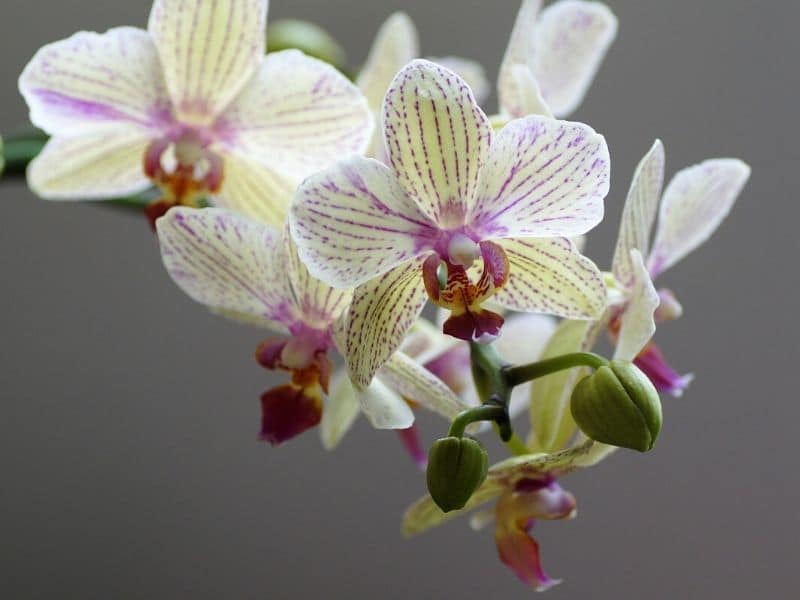
These plants typically have short stems with few to several leaves, usually arranged closely together in two rows. The leaves are large and somewhat leathery, green or spotted, flat, oblong to elliptic, drooping, and sometimes succulent.
Few to many flowers, which are often showy, fragrant, and long-lasting, are arranged on erect, drooping flower spikes. They resemble a moth, primarily because the lateral sepals are often more prominent than the dorsal sepal, plus the petals are more outspread than any of the sepals. The lip or labellum is attached to the column.
Popular Phalaenopsis Species You Can Grow
There are several plants in the Phalaenopsis genus, including those recognized by the American Orchid Society. Let’s take a look at some of the best options for potted orchids for home growers…
Phalaenopsis amabilis
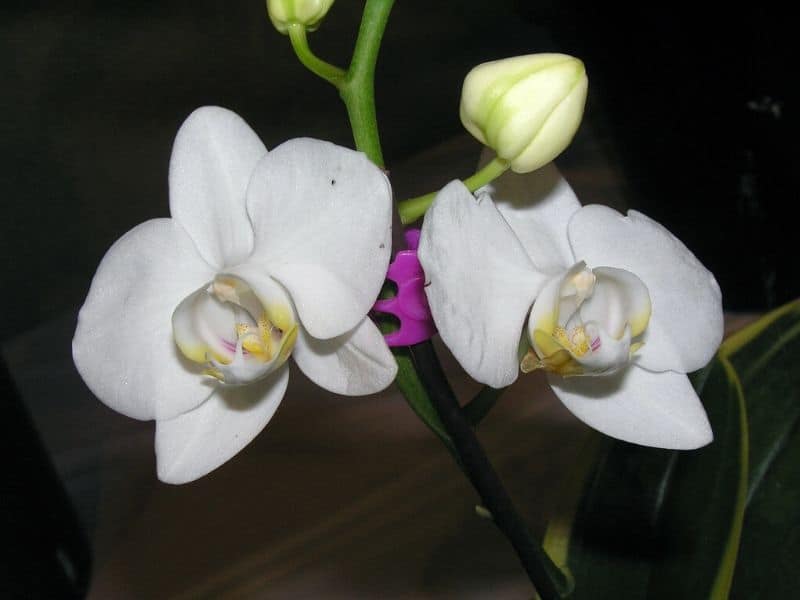
Common names: White Moon Orchid, Moon Orchid, Moth orchid
White moon orchid or Phalaenopsis amabilis is one of the most recognized Phalaenopsis species. It is commonly found in Australia, the Philippines, and Indonesia. It is the national flower of Indonesia, where it is known locally as anggrek boelan.
The species name amabilis comes from a Latin word that translates to lovely, a description apt for this orchid’s stunning flowers. The small, rounded, white flowers have flat and rounded petals that are larger than the sepals (3). Each flower typically measures 4 inches.
This species tends to produce two arching or branched flower spikes at the same time, often resulting in a striking display of blooms that typically last for three weeks. The leaves of this species are ovoid and dark green.
There are three recognized subspecies of P. amabilis, namely: P. amabilis subsp. amabilis, P. amabilis subsp. moluccana, and P. amabilis subsp. rosentromii. Out of these three, the first one is the most widespread and most recognized subspecies of moon orchids.
One of the most recognized varieties of this phalaenopsis orchid species is the variety grandiflora (P. amabilis v. grandiflora). It is a prolific moon orchid that blooms 30 to 40 flowers on 4 to 5 flower spikes.
Some of the most popular P. amabilis primary hybrids are as follow:
- P. amabilis x hieroglyphica ‘Aladdin’
- P. amabilis x equestris ‘Artemis’
- P. amabilis x celebensis ‘Celebes Beauty’
- P. amabilis x florensis ‘Florabilis’
- P. amabilis x sanderiana ‘Rimesand’
Phalaenopsis aphrodite
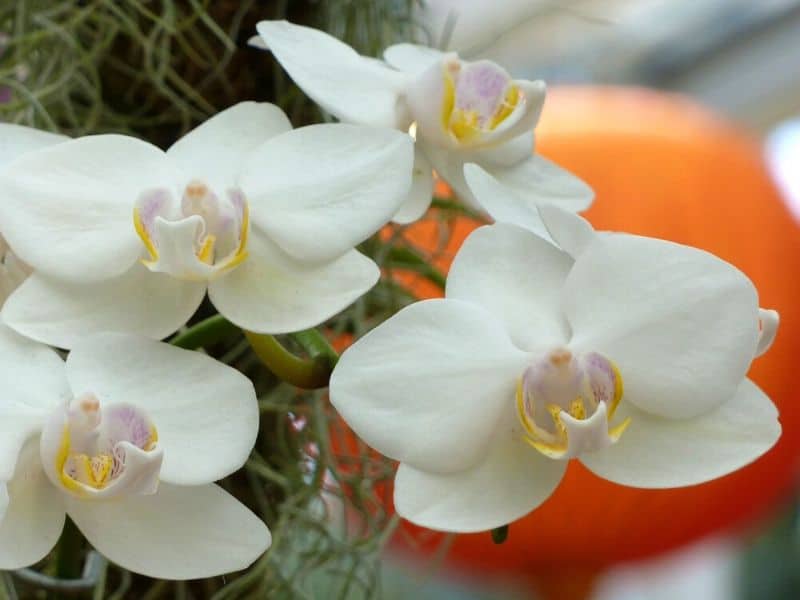
Common name: Aphrodite’s Phalaenopsis
Phalaenopsis aphrodite is another well-received species of phals with many commercially available hybrids. It is native to Taiwan and the Philippines.
Often confused with or as a varietal form of P. amabilis, this species bears oblong to elliptic leaves that are deep green in color and purple underneath. The white flowers have a close resemblance to P. amabilis, but are often smaller (about 3 inches in size) and feature a reddish lip disc and triangular mid lobe.
Some of the most popular P. aphrodite primary hybrids are as follow:
- P. aphrodite x sanderiana ‘Alger’
- P. amabilis x aphrodite ‘Bataan’
- P. bellina x aphrodite ‘Aphrodite’s Bell’
- P. aphrodite x honghenensis ‘Athena’
- P. aphrodite x kunstleri ‘Childhood’s Dream’
- P. aphrodite x equestris ‘Intermedia’
- P. aphrodite x pulcherrima ‘Maurensis’
Phalaenopsis schilleriana
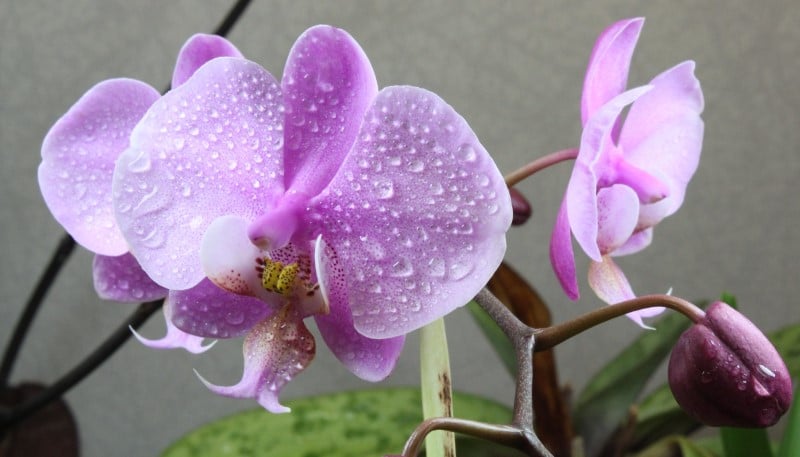
Common names: Schiller’s Pink Moth Orchid, Schiller’s Orchid
Phalaenopsis schilleriana or Phal. schilleriana is a pink-flowered phal orchid endemic to the Philippines. Its mottled leaves are green with purple undersides. The roots are flat and often produce keikis (3).
The candy pink blooms are fragrant and bloom in succession on long, branched spikes. Their lips vary in color, which can either be white or magenta (3).
It was first described by German botanist and orchid expert H.G Reichenbach in 1860 and named after the first person who made it flower, Consul Schiller.
Some of the most popular P. schilleriana primary hybrids are as follow:
- P. schilleriana x speciosa ‘Almaho’
- P. schilleriana x lindenii ‘Baguio’
- P. schilleriana x parishii ‘Pink Heart’
- P. equestris x schilleriana ‘Schiller’s Horse’
Phalaenopsis fasciata
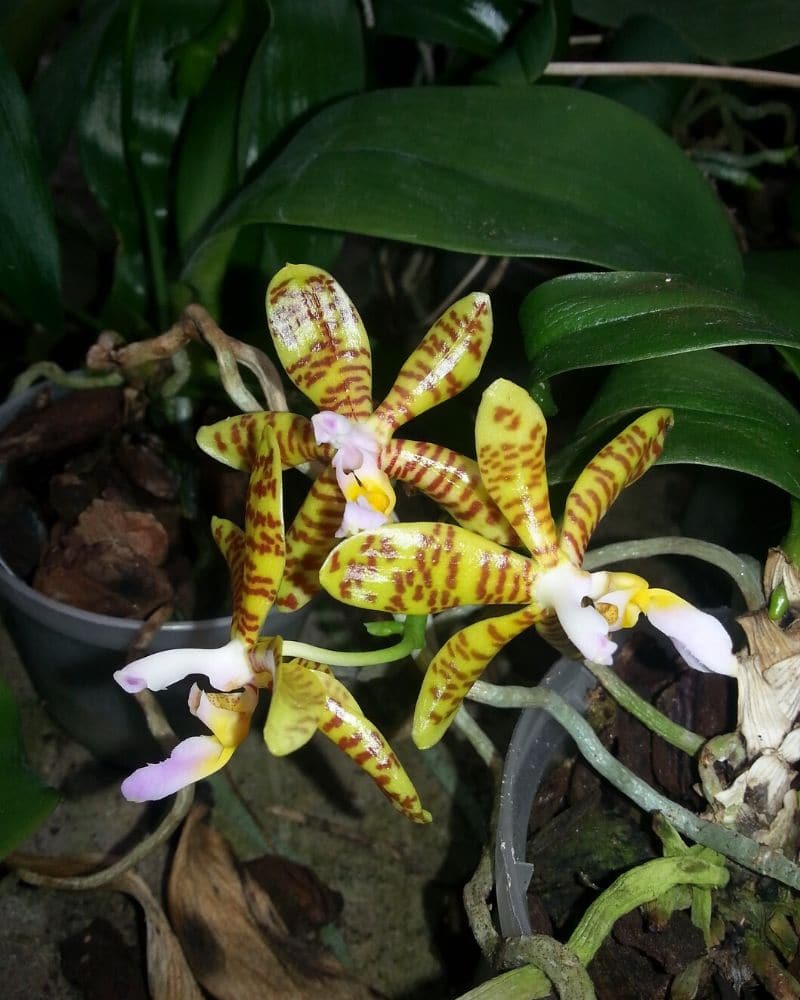
Common name: Striped Flower Phalaenopsis
Phalaenopsis fasciata, otherwise known as the striped flower phalaenopsis, is a small-sized species of phal orchids endemic to the Philippines. It is characterized by its small, greenish-yellow flowers that flaunt distinctive thin brown stripes on the sepals and petals. The flowers are long-lasting and typically fragrant. A single inflorescence can bloom new flowers for years.
Often confused with Phalaenopsis luddemannia and Phalaenopsis reichenbachiana, the lip of this particular species is not triangular and features callosities that point backward.
The species name fasciata originated from the Latin word fasciatus, which means “banded.”
Some of the most popular P. fasciata primary hybrids are as follow:
- P. fasciata x equestris ‘Apricot Glow’
- P. maculata x fasciata ‘Little Mac’
- P. fasciata x violacea ‘Norman’
- P. pulcherrima x fasciata ‘Red Elf’
Phalaenopsis bellina
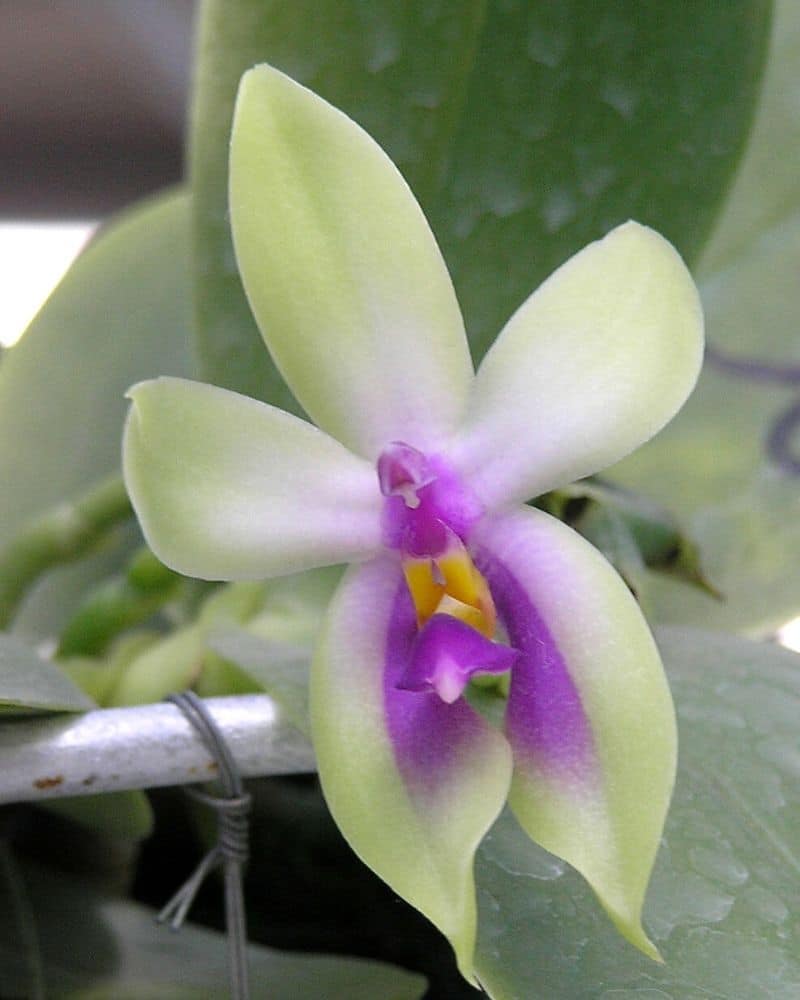
Common name: The Beautiful Phalaenopsis
Phalaenopsis bellina is a small-sized phals species native to Borneo and Malaysia. It blooms in the summer and fall, showcasing waxy, greenish flowers with streaks of purple coloration toward the center. The narrow and elongated lip also flaunts a striking purple hue.
Some of the most recognized Phal bellina primary hybrids are as follow:
- P. bellina x amabilis ‘Amabell’
- P. bellina x lueddemanniana ‘Borneo Star’
- P. bellina x hieroglyphica ‘Martina Lippold’
- P. bellina x violacea ‘Samera’
- P. bellina x tetraspis ‘Tetra Bell’
- P. bellina x inscriptiosinensis ‘Cecile’
- P. bellina x pulchra ‘Cherry Spot’
Growing Phalaenopsis Orchids: General Care and Maintenance
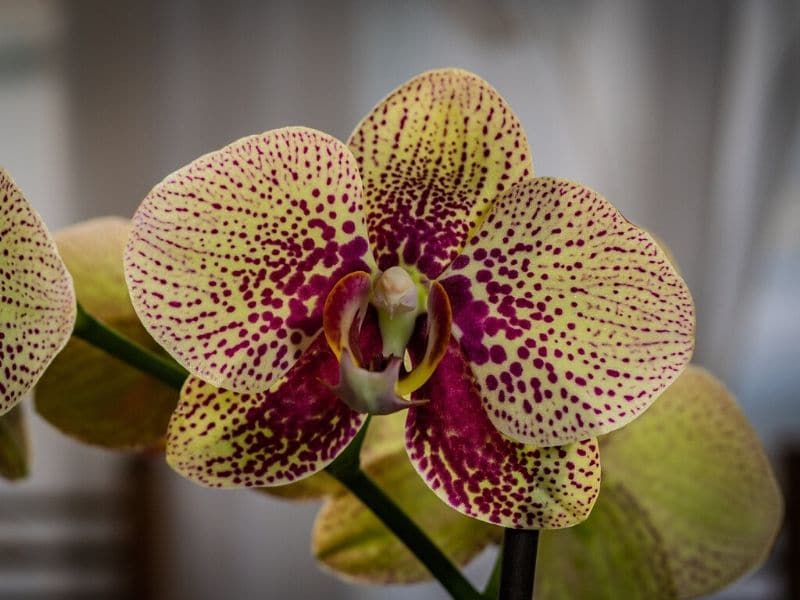
One of the many reasons why phal orchids became so popular is their easy to care nature. Sure, they flaunt beautiful flowers that are not only fragrant but also long-lasting, but the fact that growing them is not as complicated as with other orchid types makes it a favorite for many orchid enthusiasts.
As with any other orchid plants, the cultural requirements for growing phals depend primarily on the species or group where they belong. Some phals prefer warmer temperatures, while other species are more tolerant of the opposite – and that’s just one example.
Here are some basic tips on phalaenopsis growth, care, and maintenance.
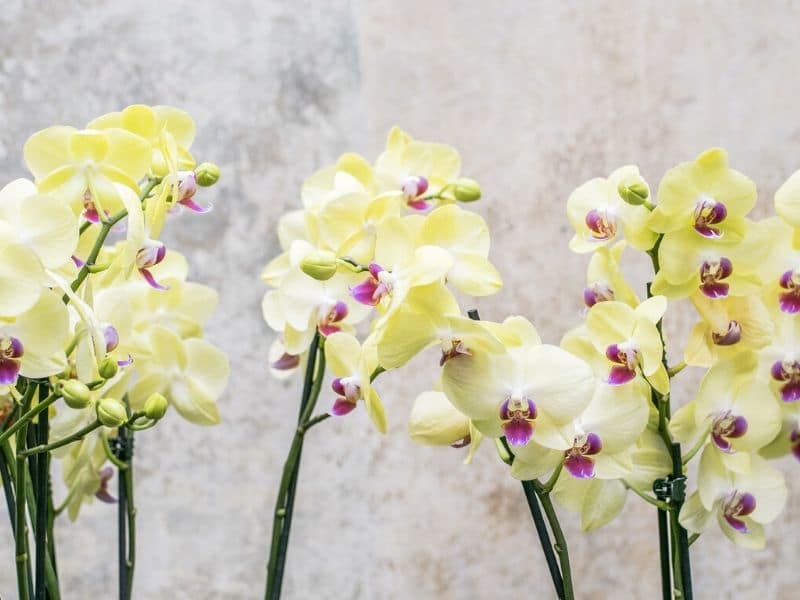
Light
Phalaenopsis are generally low light orchids. They thrive best in the shade with no direct sunlight. However, some species like P. schillerina and P. stuartiana can tolerate brighter conditions.
The leaves of phals are a good indication of whether or not the plant is receiving sufficient light. Darker leaves mean that the plant needs more light, while red-tinged orchid’s leaves are a sign of excessive light.
Grow your plant in a south or west window, which will mimic the natural habitat and encourage excellent orchid growth without problems related to too much light, like light green leaves, yellowing leaves, and so on. This will also encourage lots of long lasting flowers!
Temperature and Humidity
The temperature requirements of phalaenopsis orchids are above 60 degrees F at night and between 70 degrees F to 80 degrees F during the day. Cooler night temperatures (55 degrees F) in the fall will encourage flowering.
Note that fluctuating temperatures may result in droppings of ready-to-open buds. Pay attention to daytime temperatures when caring for your orchid. If the temperature is too extreme, it can cause problems such as wilted leaves or flower buds that refuse to bloom.
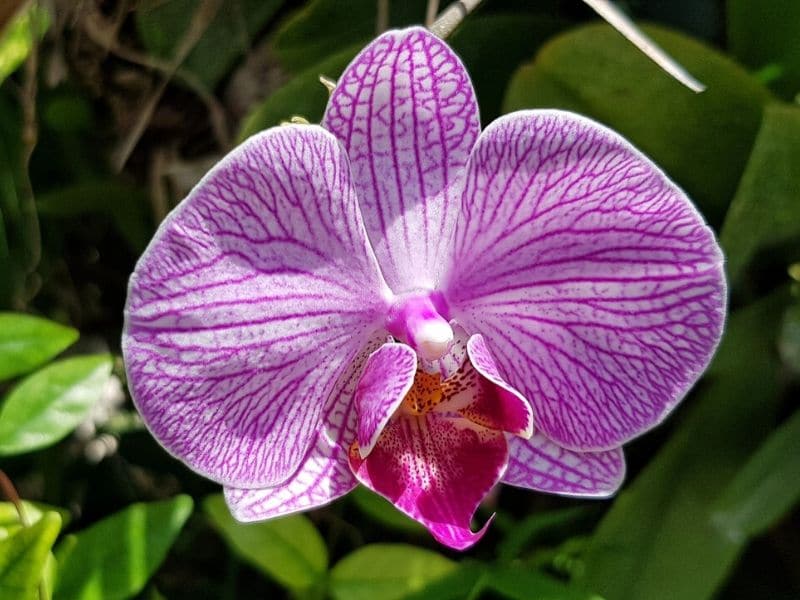
Water
The phalaenopsis orchid plant is going to prefer moist but not soggy conditions. The watering rate depends on several factors, including the type of potting medium, pot size, and different environmental conditions.
Still, the general rule is to water when the medium feels dry. Watering once a week is ideal, but it should be more frequent during the summer months to give your plant enough water when grown indoors throughout the warmer growing season.
As with other orchids, it’s best to water phalaenopsis orchids in the morning to allow the leaves to dry out before night time. Avoid overwatering since it may result in root rot and crown rot.
If you can, use distilled water to make sure the plant’s beautiful green leaves aren’t affected by chemicals in tap water.
Fertilizer
Fertilize your phalaenopsis orchid plans using any balanced orchid fertilizer (20-20-20) regularly. Fertilizing half-strength once a week or every other week in the summer, or once a month during the winter is ideal.
Growing Media and Pot Size
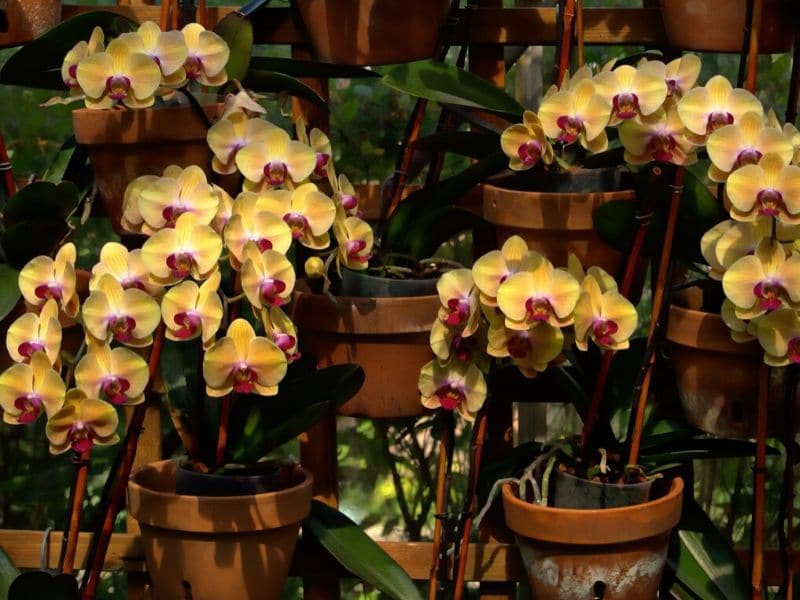
The choice for growing media or potting mix and pot size varies depending on the plant’s current growth stage and climate conditions. Phalaenopsis orchid plants are usually cultivated in terra cotta pots measuring 4 to 6 inches in diameter.
As they mature, they should be repotted once every one to three years into a bigger pot (about 1 inch in diameter bigger than the previous pot).
As for the growing media, the phalaenopsis orchid grows best when water and air are allowed to move freely around the roots. In this case, bask, and peat-based media are ideal. Peat moss or sphagnum moss are both good choices – sphagnum moss will help you prevent under watering and ensure your plant has the ideal growing conditions.
Other good options to care for your orchid roots include fir tree bark potting media, redwood bark chips, or coconut husk chips.
Propagating a New Flower
Phalaenopsis orchids are popular indoor plants known for their stunningly beautiful and fragrant flowers. However, over time, the parent plant may begin to experience issues such as bud blast, dead roots, and a slowing growth rate. When this occurs, it is time to consider propagating a new plant, which can be easily achieved with just a few simple steps.
To begin this process, you will need clean pruning shears and a clean paper towel. Start by removing the top portion of the parent plant just above a node, ensuring that you have a small section of stem with several good roots intact. This will serve as the new stem section for your propagated plant.
Next, prepare a new pot with fresh potting mix for the baby plant and place it in a west-facing window where the orchid can receive indirect light. Phalaenopsis orchids thrive in temperatures of around 60°F, so be sure to keep the plant in a relatively cool location.
Now that you have your new stem section, it’s time to take the necessary steps to encourage root growth. Carefully remove any dead roots and spray the remaining healthy roots with a mist of water. Allow the roots to dry for several hours before placing the stem section into the potting mix, ensuring that it is planted securely.
Pruning Your Plant
As your new plant begins to take root, it is essential to monitor its growth and provide the necessary care to ensure its success. Phalaenopsis orchids have a dormancy period, during which growth slows, leaves may yellow and die, and the orchid enters a state of rest, often during the winter months.
During this time, be sure to provide the plant with the right amount of light and water.
One of the best ways to encourage flowering in your new propagated plant is to prune it regularly. Remove any dead or dying leaves, as well as any portion of the plant that seems to be struggling.
Pruning not only helps to promote new growth, but it also encourages the plant to produce multiple flower buds, resulting in a more beautiful and vibrant display.
Common Orchid Problems
One of the most prevalent issues is too much moisture, which can lead to the orchid suffering from root rot. You may notice brown or black leaves as a result. To combat this problem, it is important to provide excellent drainage for your orchid. This will allow excess water to flow out of the pot and prevent the roots from suffocating in a wet medium.
Another issue that orchid growers face is the presence of brown roots. This could indicate that the orchid has not been receiving proper care, or that it has been exposed to conditions that are too harsh. If you notice brown roots, it is important to carefully remove them to prevent the spread of any potential diseases.
Air circulation is another critical factor in caring for orchids. If the orchid is not getting enough air circulation, it may suffer from bud blast, which is the loss of flower buds before they even have a chance to bloom. To prevent this problem, consider placing a fan near your orchid to ensure that it is getting enough air movement.
If you are using a suffocating medium that does not provide enough air circulation for your orchid, it may suffer from various orchid diseases. These can range from fungal infections to bacterial diseases that can quickly spread throughout the plant.
In addition to providing proper air circulation, it is important to avoid over fertilizing your orchid. This can lead to an increase in salts in the soil, which can cause a range of issues for your orchid. Only fertilize your orchid once a month, and only with a fertilizer that has been specifically designed for orchids.
Is the Phalaenopsis Orchid Right for You?
The Phalaenopsis orchid is an excellent plant for indoor gardening year round due to its beautiful arching branches of individual flowers, which can result in more blooms.
With proper growing conditions, including temperature, humidity levels, and potting mix, the plant can thrive year-round. They are easy to grow and require low-maintenance, like weekly watering and carefully deadheading.
Overall, a Phalaenopsis orchid is a stunning addition to any home and a rewarding plant to grow.
References
Reference List:
- Magdalita, P., San Pascual, A., and Villareal, R., 2020. Characterization and Flowering Behavior of Eleven Philippine Native Phalaenopsis Species and Gamma Irradiation Effects on Phalaenopsis aphrodite. Philippine Journal of Science, [online] Available at: http://philjournalsci.dost.gov.ph/images/pdf/special_issue/148_S1/characterization_and_flowering_behavior_of_phalaenopsis_species__.pdf
- Aggie-horticulture.tamu.edu. (2020). Orchidaceae or Orchid Family. [online] Available at: https://aggie-horticulture.tamu.edu/syllabi/302/new/family/orchidaceae.html
- Teoh, E., 2009. Orchids Of Asia. Singapore: Marshall Cavendish Editions.
Close
*Photo by mira.drozdowski.gmx.de/depositphotos

